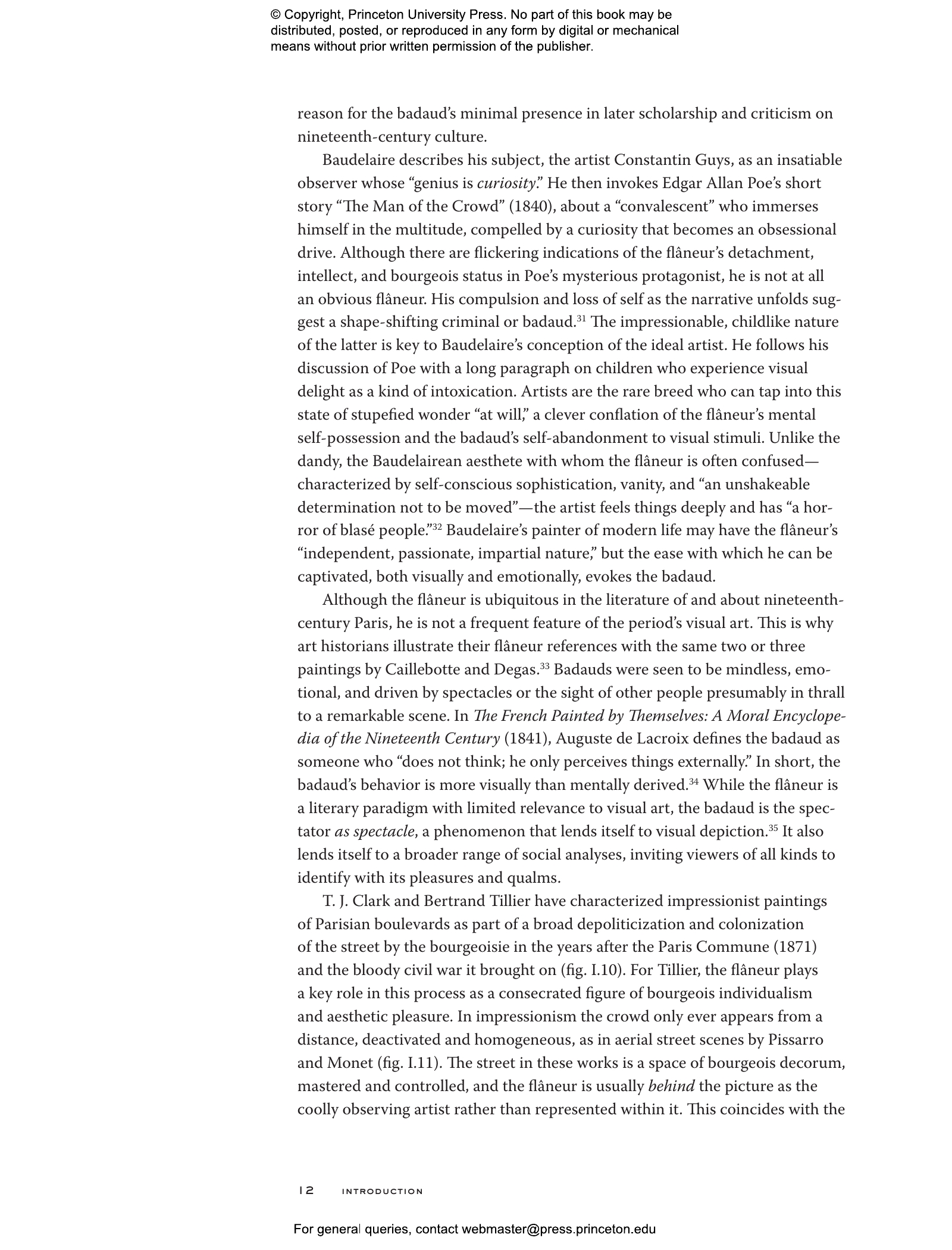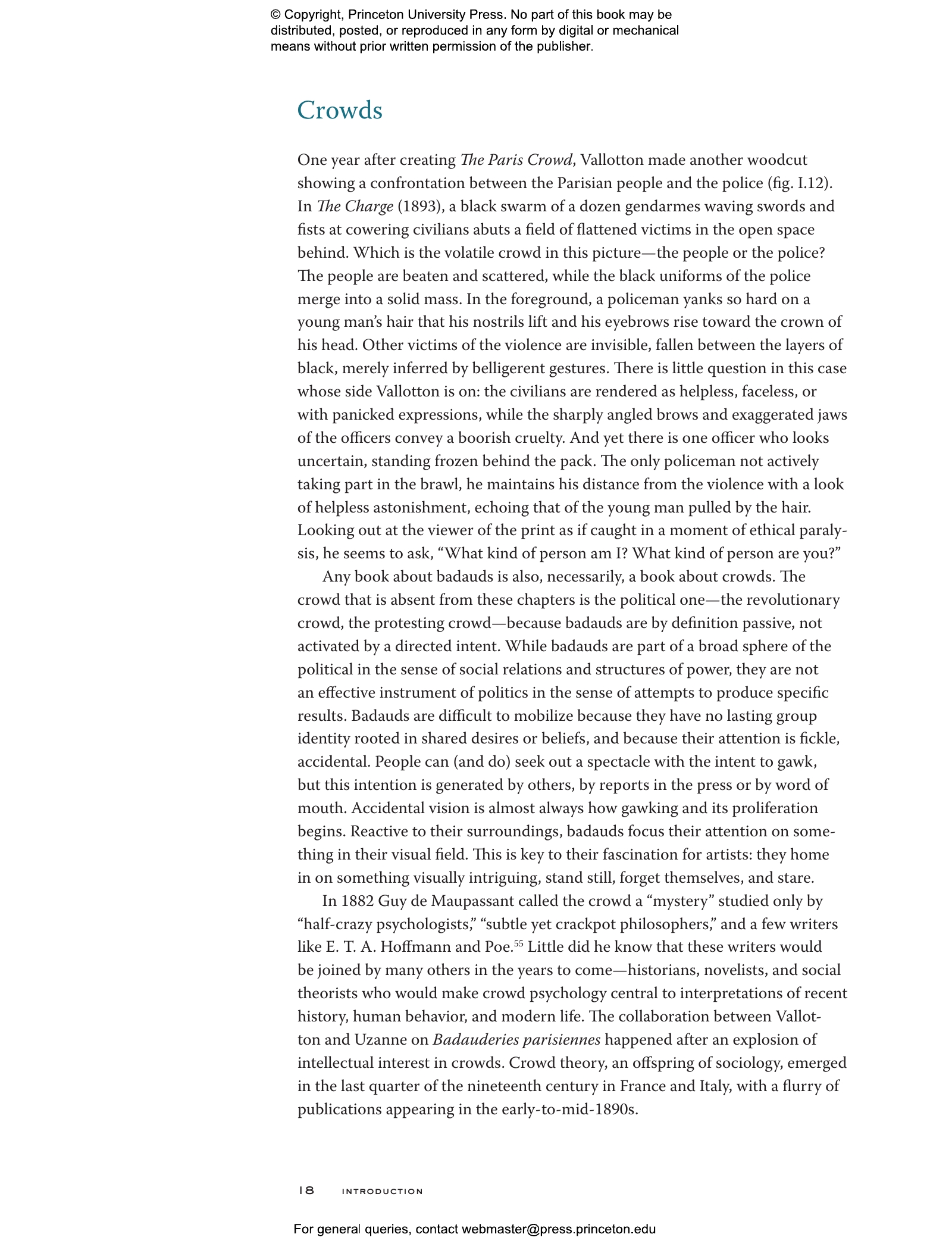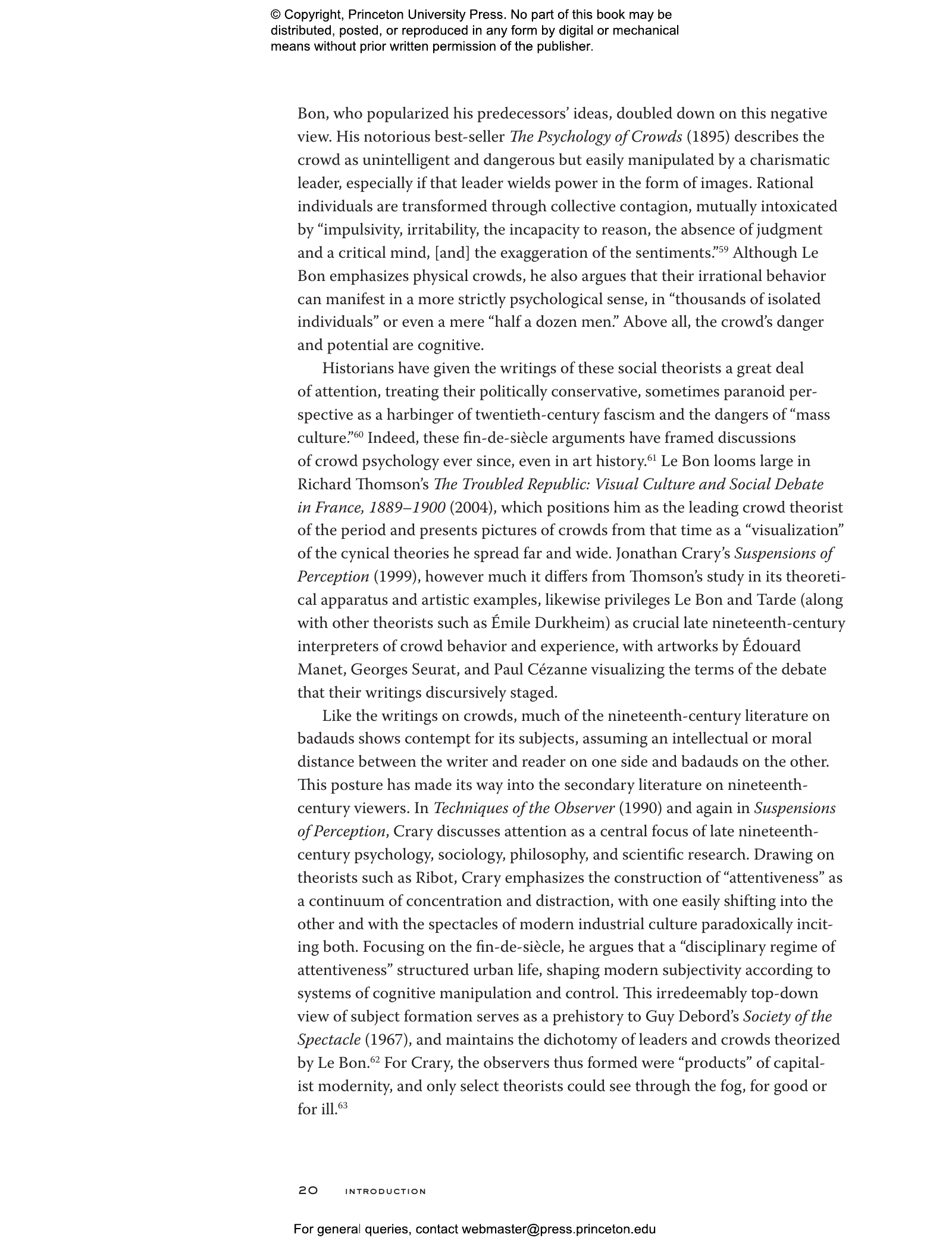Gawkers explores how artists and writers in late nineteenth-century Paris represented the seductions, horrors, and banalities of street life through the eyes of curious viewers known as badauds. In contrast to the singular and aloof bourgeois fl芒neur, badauds were passive, collective, instinctive, and highly impressionable. Above all, they were visual, captivated by the sights of everyday life. Beautifully illustrated and drawing on a wealth of new research, Gawkers excavates badauds as a subject of deep significance in late nineteenth-century French culture, as a motif in works of art, and as a conflicted model of the modern viewer.
Bridget Alsdorf examines the work of painters, printmakers, and filmmakers who made badauds their artistic subject, including F茅lix Vallotton, Pierre Bonnard, Henri de Toulouse-Lautrec, Honor茅 Daumier, Edgar Degas, Jean-L茅on G茅r么me, Eug猫ne Carri猫re, Charles Angrand, and Auguste and Louise Lumi猫re. From morally and intellectually empty to sensitive, empathetic, and humane, the gawkers these artists portrayed cut across social categories. They invite the viewer鈥檚 identification, even as they appear to threaten social responsibility and the integrity of art.
Delving into the ubiquity of a figure that has largely eluded attention, idling on the margins of culture and current events, Gawkers traces the emergence of social and aesthetic problems that are still with us today.
"A rich, dense, wide-ranging survey whose central figure is the Swiss artist F茅lix Vallotton. . . . Alsdorf is an admirable close reader of images, clever at picking out, in a mass of bodies, a tiny figure who is doing nothing more than staring back at us, as if, across the centuries, he has spotted us gawking at him and is gawking back."鈥擩ulian Barnes, New York Review of Books
"Handsomely produced, exhaustively researched, Gawkers combines elegant prose with a knowingness that mimics the sly humour of its key figures. . . and penetrating visual analyses of their works"鈥擫esley Stevenson, World of Interiors
"Alsdorf acts as a knowledgeable guide to Parisian art of the nineteenth century. . . . Gawkers is recommended for enthusiasts of art of this period, as it effectively supplies a missing link for non-francophones, introducing them to the complex social signals and commentary that is present in the art we so often take for granted."鈥擜lexander Adams, Alexander Adams Art
"Bridget Alsdorf is a wonderfully clear writer. . . . Gawkers is engaging, thoroughly researched, and generously illustrated."鈥擧eather Saunders, ARLIS/NA Reviews
"The crowd as Alsdorf envisions it turns out to be multifaceted, variously dense, and dependent on an unprecedented relationship to the spectacular. For those who follow developments in the field of the history of art in the 19th century, Alsdorf's voice has gradually revealed itself, original, elegant, knowing how to combine descriptive precision and an overall vision of the dimensions of a period. Following her masterful analysis of the portraits of Fantin-Latour from her previous book (Fellow Men, 2013) is this fascinating contribution, with tight argumentation and marvelous illustrations."鈥擩ulien Zanetta, Studi Francesi
"In this wide-ranging and content-rich study, Alsdorf succeeds in bringing the many facets of badauderie closer to her readers. She elucidates how closely the act of gawking in urban space is intertwined with art's ability to get people to look.… Her methodological approach is also enriching with a view to current affairs: the question of how a medium makes its audience its own subject proves fruitful beyond nineteenth-century Paris."鈥擬ichelle Sturm-M眉ller, 21: Inquiries into Art, History, and the Visual
"Alsdorf’s fine monograph allows a fresh perspective on late-nineteenth-century France, on its spectacles and streets, and on the figures which depicted and shaped a rapidly changing world. It is a welcome addition to a growing body of work that seeks to offer a counterpoint to the vision of leisure and fl芒nerie that has dominated discussions of late-nineteenth-century French art, and will no doubt benefit scholarship in French studies, art history, and theatre studies."鈥擟laire Moran, French Studies
"[Gawkers] offers a genuinely new way of considering printmaking, its makers and its audiences during an especially rich moment in the medium’s history and is sure to inspire future work in this field."鈥擝ritany Salsbury, Print Quarterly
"Gawkers thoroughly succeeds in its mission to make us pay attention to those rubbernecking onlookers who stand at the margins of the scene; their perspective reveals new elements of Parisian modernity. Enlivened by fluid writing, close nuanced analysis, and a rich corpus of visual material, Gawkers will be of great use to specialists, and a thoroughly enjoyable read for a wider audience."鈥擲amuel Raybone, H-France
"[Gawkers] serves a valuable purpose, both as an encyclopedia of nineteenth-century images of gawking and as an introduction to the subject of the badaud."鈥擯atricia Mainardi, Journal of Modern History
“Gawkers represents a long-awaited return of late nineteenth-century Paris to central importance in the practice of art history. This book is unfailingly logical, yet rich with arresting twists and surprises. The poise and elegance of its prose never disappoints.”—Thomas Crow, author of Restoration: The Fall of Napoleon in the Course of European Art
“Beautifully written and meticulously researched, Gawkers is wide-ranging and deep in its treatment of history. Alsdorf virtually compels us to recognize, through the power of her prose, her command of social and political history, and imaginative, razor-sharp visual analysis, that the figure of the gawker must be seen and understood.”—Susan Sidlauskas, author of C茅zanne’s Other: The Portraits of Hortense
“Renewing our understanding of the visual and artistic culture of fin-de-si猫cle Paris, Gawkers is a master class in the construction of the modern subject, especially in its urban milieu. Through a multitude of perspectives, Alsdorf grasps and reveals this new being without qualities, who is no longer a fl芒neur and not yet a mass man.”—脡ric Michaud, author of The Barbarian Invasions: A Genealogy of the History of Art
“When we think of French modernity and its dual iconography, we commonly think of Baudelaire’s fl芒neur. Yet thanks to Alsdorf’s enlightening and multifaceted book, we realize the importance of other social figures. This 'era of crowds' gave birth to alternative images and new artistic strategies. Through Gawkers, we gain a fresh understanding of the period.”—St茅phane Gu茅gan, author of Painting: Mus茅e d’Orsay

































